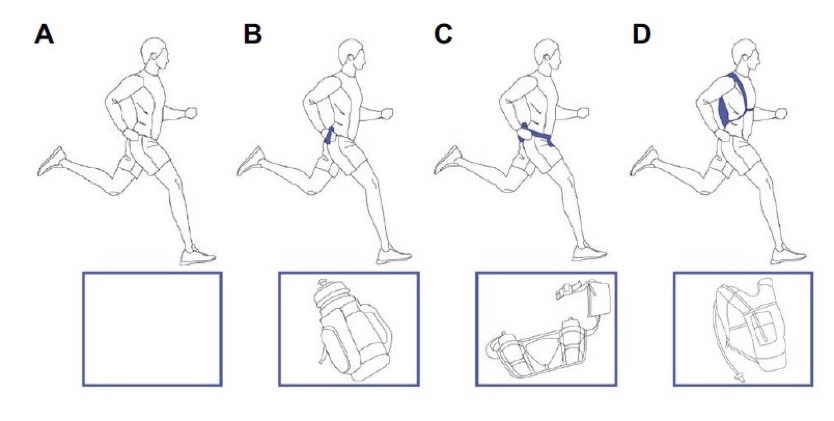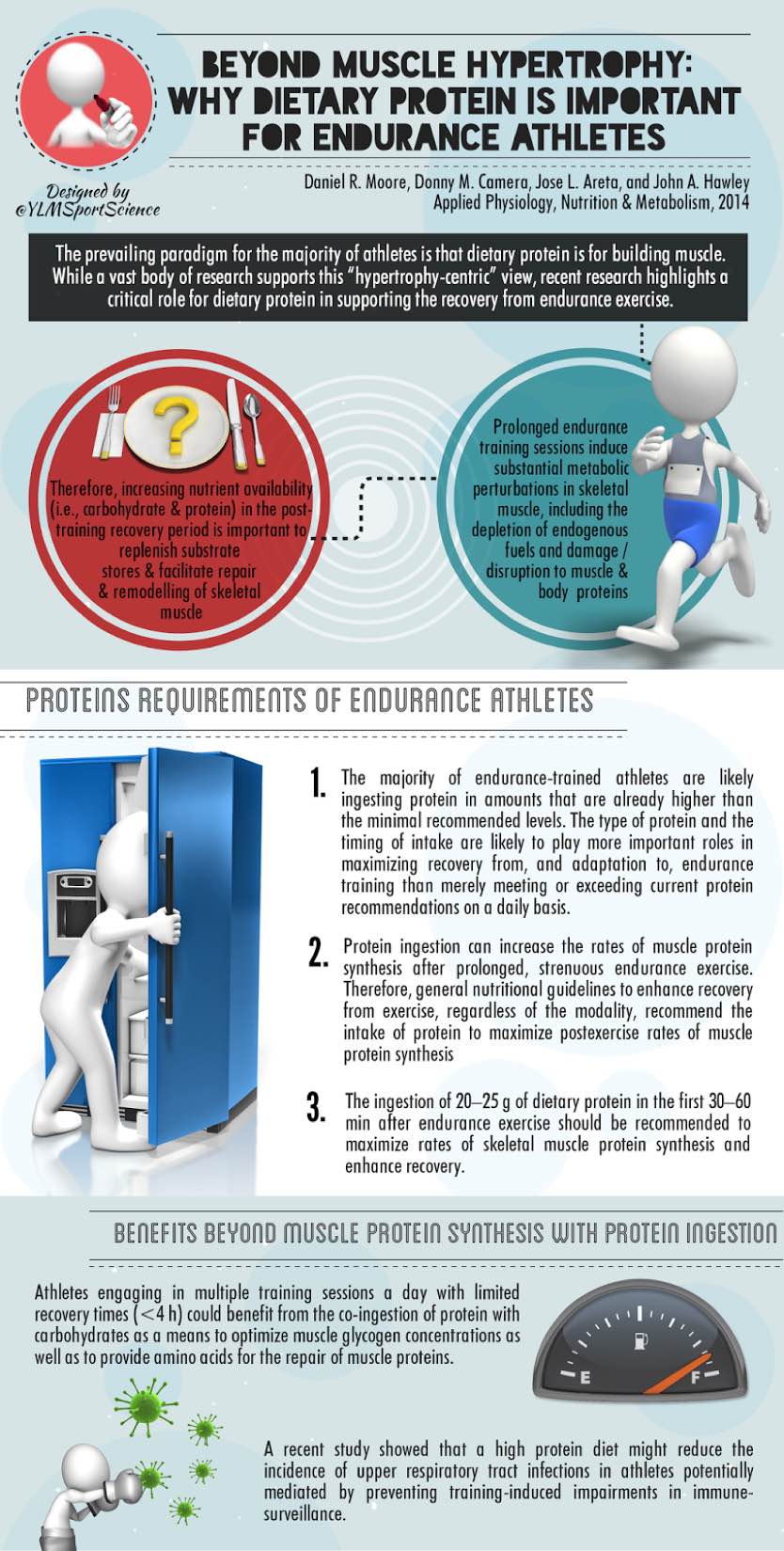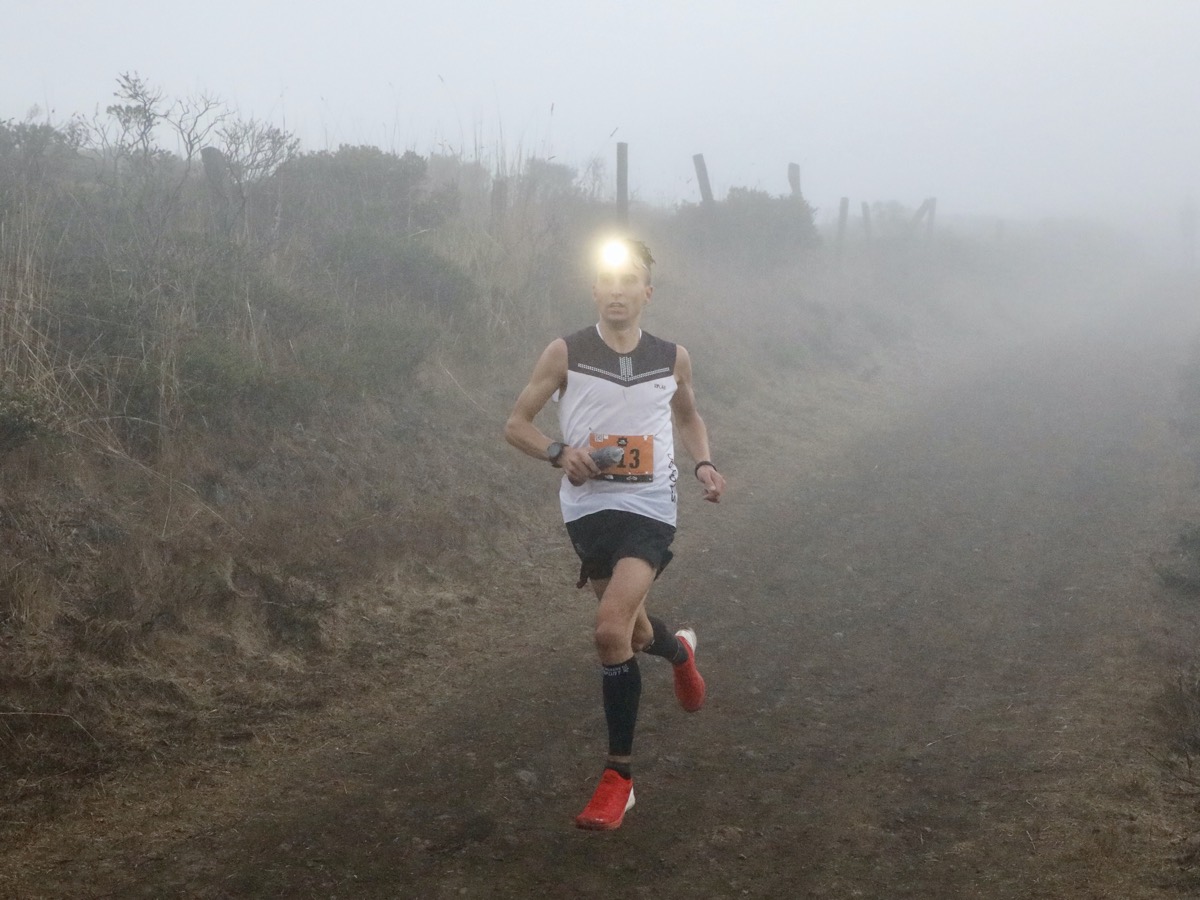Welcome back to the third edition of Running on Science’s mythbusting approach to science! In this episode, we examine three more discussion topics that float around trailheads and amongst running friends. We use current–sometimes very current!–scientific understanding to see if these “factoids” are indeed fact, fiction, or something in between.
Fact or Fiction: “Handheld water bottles create biomechanical imbalances when running.”
The trail and ultrarunning world has come a long way over the past 50 years, from utilizing recycled objects to carry water and food during long training runs and races to a wide variety of options. This includes handheld water bottles, hydration vests, and waist packs. Over the past decade and corresponding with the growth of our sport, research has looked at the performance implications of using one method of carrying over another. It’s logical that keeping the load to a minimum is important to limit physiological strain on the body over time, but studies until recently had left more questions than answers when we break apart their methodology.
The more prominent studies evaluating water-carrying position have primarily been done with military populations, hikers, or walkers, and have generally been conducted at slower speeds and with heavier loads than we encounter while running (1). The knowledge we did gain from these studies was that load position (at those speeds and weights) likely influences energy expenditure and they pointed toward carrying loads closer to your center of mass–on your core versus on your limbs–as being most efficient. There have been a few studies specifically with runners that have found potential rationales for why both hydration vests and handheld water bottles (unilateral, only held in one hand) could lead to increased energy expenditures due to alterations in biomechanics (2, 3). Unfortunately, although these studies have sound hypotheses, they too had methodological issues and only observed energy demand during a 5-minute testing period and were unable to determine energy-expenditure changes (1). Despite this, these studies did influence a general market shift away from handheld water bottles and toward hydration vests.
Enter the newest study published this fall that looked at energy-expenditure changes in 4 different carriage systems (no carry/control, waist pack, hydration vest, and handheld water bottle) (1). This was an explorative study utilizing 12 male runners, running for 60 minutes in each trial. What they found over the course of the study was that economy (the cost of exercise/oxygen required to perform work at a given speed) deteriorated to essentially the same extent over time across all three carriage systems when carrying even 1 liter of fluids compared to the control/carrying nothing. However, no one system was worse than the other, and it often came down to the personal preference of the volunteer when they were asked for how the effort was perceived in each trial.

There are many different ways to carry fluids and nutrition during training runs and races. These were the four conditions tested in the most recent study of carriage systems in endurance running. Image: Scheer V, Vieluf S, Bitter N, Christ L and Heitkamp H-C (2020) (1)
Conclusion
It’s a toss-up, at least for now. Research in this area is still relatively new, and there have been many suggestions for methodological improvements in future studies. What we should note for now is that how we carry weight on the run can influence our biomechanics and so there is probably a reason why you have your own personal preference. Put well by Scheer and colleagues, “…In sports sometimes small, nonsignificant changes can be meaningful, especially for the individual…” (1).
Fact or Fiction: “Endurance runners don’t need much protein in their diets.”
When it comes to the endurance-athlete diet, it’s easy to get lost in the high-carbohydrate versus high-fat debate and forget entirely the third macronutrient, protein. Additionally, because we know the primary macronutrient/energy source for endurance performance is carbohydrates, it’s also easy to skew our focus toward getting enough of that in our diet. And finally, concerns over getting enough protein normally fall to athletes who are focused on muscle growth, such as the strength and conditioning community. All this does not mean that protein is not important for endurance athletes!
When you exercise for either long periods of time or at higher intensity, you place significant metabolic demands on your body. This includes depleting your endogenous fuel stores (both muscle and liver glycogen), body fluid (through sweat and respiration), and electrolytes, as well as causing hormonal perturbations and damaging skeletal muscles and body proteins (8). And as pointed out by Daniel Moore and colleagues, “As such, recovery strategies for competitive athletes engaged in endurance-based training typically focus on three inter-related approaches: refueling, rehydration, and repair” (8). The first two of that three-tier recovery model is easy for many of us to grasp: we recognize the extreme importance of replenishing fuel (carbohydrates to replenish depleted glycogen stores) and rehydrating post-exercise. However, this often means that we neglect the third tier, the dietary importance of protein.
Endurance athletes need protein to repair and regenerate our damaged proteins (muscle), as well as to synthesize new proteins (in our muscles and mitochondria). In large part this is one of the key ways we adapt to training, by increasing the quality of muscles by increasing mitochondrial density. Beyond protein repair and synthesis, protein can be used as fuel when broken down into amino acids which are drawn upon when carbohydrate stores run low. Protein is also important in the formation of hemoglobin (the part of the blood which carries oxygen), for how it helps control fluid volume and maintain water balance, and its positive impact on the immune system by increasing the number of CD8+ T-lymphocytes (a type of white blood cell) circulating in your blood (8).
What’s important for you to know is that generally speaking, endurance athletes need a little more than the base recommendation of 0.8 grams of protein per kilogram of body weight (g/kg). In fact, you need more like 1.2 to 1.6 g/kg, and this value could also increase during times of heightened training volume and/or intensity to as much as 1.8 to 2.0 g/kg (10). For an athlete who weighs 68kg (150 pounds), you are aiming for about 82 to 109 grams of protein per day. When we think of this in terms of what percent of our daily caloric intake should come from protein, this increases protein needs from roughly 12 to 15% of our daily calories to 15 to 20% of our daily calories. The final important piece of the protein puzzle is that timing and dose seem to matter for maximum synthesis and utilization. For this, the International Society of Sports Nutrition recommends trying to get protein in 10- to 30-gram doses every three to four hours. Additionally, and this is important, it seems that the co-ingestion of protein and carbohydrates post-run is critical for glycogen synthesis particularly when you are either intentionally or unintentionally not getting enough carbohydrates (all the recovery and refueling!)

It’s important to ingest protein in proper quantities that support recovery and endurance performance. Image: Ylmsportscience.com/2014/10/23/beyond-muscle-hypertrophy-why-dietary-protein-is-important-for-endurance-athletes-by-ylmsportscience/
Conclusion
Straight up fiction! Despite being carbohydrate fiends, endurance athletes not only require adequate daily protein ingestion, but also need more than their peers who are sedentary and who recreate less. We can argue that under fueling in any of the macronutrient families (carbohydrates, proteins, and fats) can have negative consequences. Let’s take in enough protein!
Fact or Fiction: “Compression socks and sleeves prevent soreness during an ultramarathon.”
Compression socks and calf sleeves are not an uncommon sight at ultramarathons these days, but what do they actually do besides cover the lower-leg tattoos I assume you’re all hiding? Compression garments are widely used in clinical settings where they are aimed at improving venous return, or limiting blood pooling at the extremities, most frequently during times of recovery and decreased physical movement (5). It’s the same reason travelers also rely on compression garments (goodbye cankles) and why compression garments worn post-exercise can be beneficial for recovery. Essentially, the compression applied (if tight enough) reduces the extracellular space available for swelling to occur (6).

Your veins utilize one-way valves and muscle contractions to keep blood from pooling at your extremities. This is greatly impacted by age (as we age our veins loose some of their elastic properties and are more prone to distortion) and movement (when we don’t contract our muscles, blood works against gravity on its own to try to return to your heart via your veins). Image: Podiatryhq.com.au/feet-ankles-swell/
But what about wearing compression during a long run or race? We know that training and racing can result in exercise-induced muscle damage (EIMD). This is completely natural and influenced by exercise type, duration, intensity, and how accustomed you are to that type of exercise. We also know that exercise which has an eccentric component, like downhill running, causes greater EIMD. The symptoms of EIMD vary, but generally include a temporary reduction in muscle strength, decreased rate of force development, reduction in range of motion, swelling, increased feelings of soreness, and the appearance of intracellular proteins in your blood (like creatine kinase, an enzyme that leaks out of damaged muscles during and post event) (6). These symptoms can last for a number of days and are generally associated with what we know as delayed onset muscle soreness (DOMS). However, given that we run for very extended periods of time (generally outside the scope of these studies), it’s logical to consider how EIMD might affect us during an event as well. Or more practically, does wearing compression garments like calf sleeves or compression socks to below the knee increase performance by decreasing the rate of EIMD onset?

Seb Spehler wearing lower-leg compression during the 2019 The North Face 50 Mile Championships. Photo: iRunFar
A comprehensive review (32 articles published between 1987 and 2015) looking at the performance effects of wearing compression garments including knee-high socks (most prevalent), tights, knee-high calf sleeves, running shorts, and whole-body compression found that compression garments created no additional benefit on racing performance (finishing time) in events ranging in distance from 400 meters to the marathon (7). However, they did see small positive effects including improvement in time-to-exhaustion tests, running economy (measure in oxygen/energy required), biomechanical variables, the clearance of blood lactate, perceived exertion, maximal voluntary isometric contraction, and peak muscle power immediately post-running, as well as markers for muscle damage and inflammation (creatine kinase) (6, 7).
The variables that showed the greatest improvement with compression were post-exercise leg soreness and DOMS, and it’s important to note that both are subjective in nature. Studies since 2016 have found similar results specifically in trail runners which better take into account prolonged and more vertical gain and loss. A study in 2017 concluded that calf compression worn during prolonged trail running time trials actually modified running biomechanics (they evaluated gait in the field), creating more dynamic behavior (greater stiffness and decreased ground contact time) and reducing the perception of pain compared to the control condition (no compression), but did not improve performance (5).
Conclusion
Yes and no, depending on what you are trying to get out of using compression. If the question is, does perceived muscle soreness, pain, and effort decrease during prolonged running when lower-leg compression is added, then this likely falls in the fact category. However, when it comes to performance, there is no significant improvement in physiological or biochemical variables when compression is added during exercise. Finally, if you are instead looking to compression from a recovery standpoint, it does appear that compression garments can reduce the severity of DOMS, accelerate return to muscle function, and attenuate the concentration of CK (6).
Call for Comments
- Fact and fiction chatting time! What water-carrying device do you prefer and why is that?
- Do you monitor your protein intake?
- How about lower-leg compression? Do you use it either during your runs or for recovery afterward?
References
- Scheer V, Vieluf S, Bitter N, Christ L and Heitkamp H-C (2020) The Optimal Weight Carriage System for Runners: Comparison Between Handheld Water Bottles, Waist Belts, and Backpacks. Front. Physiol. 11:571221. doi: 10.3389/fphys.2020.571221
- Vincent, H. K., Zdziarski, L. A., Fallgatter, K., Negron, G., Chen, C., Leavitt, T., et al. (2018). Running mechanics and metabolic responses with water bottles and bottle belt holders. Int. J. Sports Physiol. Perform. 13, 977–985. doi: 10.1123/ijspp.2017-0184
- Scheer, V., Vieluf, S., Schröder, M., Lappe, P., and Heitkamp, H. -C. (2020b). A comparison of economy between two different backpack designs for runners. Appl. Ergon. 84:103038. doi: 10.1016/j.apergo.2019.103038
- Hudson, S., Cooke, C., Davies, S., West, S., Gamieldien, R., Low, C., et al. (2018). A comparison of economy and sagittal plane trunk movements among back-, back/front- and head-loading. Ergonomics 61, 1216–1222. doi: 10.1080/00140139.2018.1474267
- Kerhervé HA, Samozino P, Descombe F, Pinay M, Millet GY, Pasqualini M and Rupp T (2017) Calf Compression Sleeves Change Biomechanics but Not Performance and Physiological Responses in Trail Running. Front. Physiol.8:247. doi: 10.3389/fphys.2017.00247
- Hill J, Howatson G, van Someren K, Leeder J, Pedlar C. Compression garments and 481 recovery from exercise-induced muscle damage: a meta-analysis. Br J Sports Med. 482 2014;48:1340-1346.
- Engel, F. A., Holmberg, H.-C., and Sperlich, B. (2016). Is there evidence that runners can benefit from wearing compression clothing? Sports Med. 46, 1–14. doi: 10.1007/s40279-016-0546-5
- Moore, D. R., Camera, D. M., Areta, J. L., & Hawley, J. A. (2014). Beyond muscle hypertrophy: Why dietary protein is important for endurance athletes.Applied Physiology, Nutrition, and Metabolism,39(9), 987-997. doi:10.1139/apnm-2013-0591
- Jager et al. International Society of Sports Nutrition position stand: protein and exercise. J Int Soc Sports Nutr. 2017. Jun 20: 14:20 https://www.ncbi.nlm.nih.gov/pubmed/28642676
- Costa, R. J., Knechtle, B., Tarnopolsky, M., & Hoffman, M. D. (2019). Nutrition for Ultramarathon Running: Trail, Track, and Road. International Journal of Sport Nutrition and Exercise
